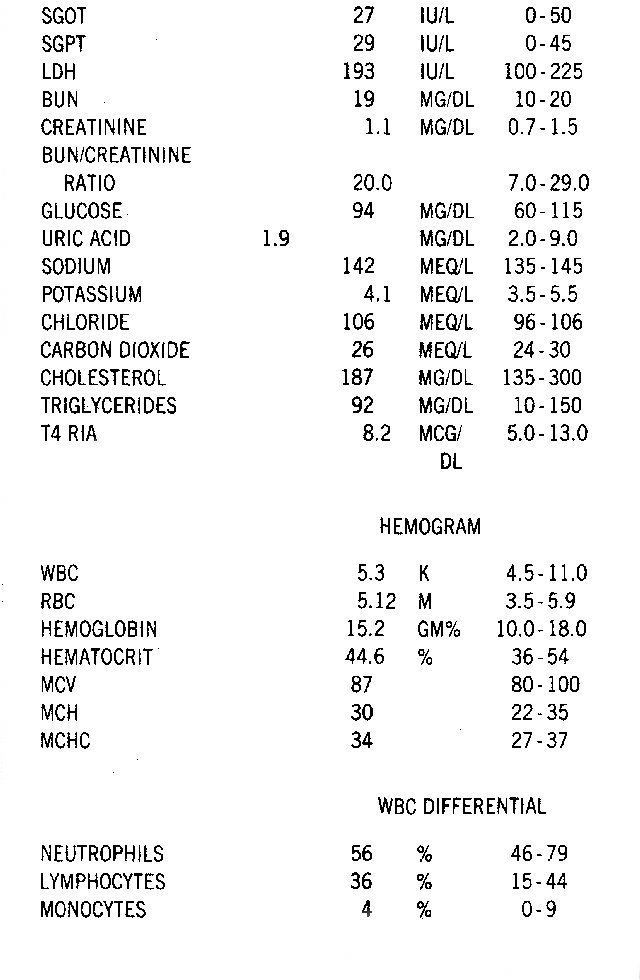PROCESSING flashed on the screen.
This search would take considerable time, so while that was going on, he cleared the screen and prepared to find out what there was to know about Dr. Alan Bulmer. He decided to start with the basics, so he cued up Bulmer's blood profile.




As expected, no abusable substances were floating around in his blood or urine.
So far so good. His cardiogram and chest X ray were normal, too. Next he cued up Bulmer's CT scan from Downstate and reviewed the series of radiographic slices of the brain at various levels with and without contrast: no infarcts or masses evident anywhere. The MRI studies done here were negative as well.
So Bulmer didn't have a brain tumor and hadn't had any previous strokes. No surprise. He moved on to see what his brainwaves looked like.
An edited version of Bulmer's twenty-four-hour EEG from yesterday scrolled horizontally across the screen. The computer presented a good sample of the six parallel zigzag lines that formed the basic electrical pattern of his brain, then edited that particular pattern out of the rest of the record, leaving only irregularities and significant variations for review.
Charles noticed immediately that the basic pattern was diffusely abnormal. Nothing terribly specific, but the background activity was disorganized, showing generalized slowing.
That puzzled Charles. This was not the type of EEG he would associate with an active professional pushing forty. It was a senile old man's EEG.
He scrolled on. The first variation showed around 7:15 a.m., when an undulating pattern began to appear, barely noticeable at first, but growing more pronounced with every passing minute. It wasn't confined to any one section of the brain, but affected all the leads, causing the lines to glide up and down. The undulation was most pronounced at 7:45, after which the magnitude of each wave began to slacken off, finally disappearing at 8:16.
Charles leaned back and chewed his lip. Odd. He couldn't remember ever seeing anything like that before. He shrugged it off. Probably some transient electrical disturbance in the telemetry. He scrolled on, finding nothing until 7:37 p.m. last night, when the same pattern repeated itself, peaking shortly after 8:00 and disappearing by 8:35.
Doubly odd. Two apparent artifacts, both identical, approximately twelve and half hours apart, each lasting an hour.
The Hour of Power!
A tingle ran up Charles' back.
He shook himself. This was ridiculous. It was just an artifact—a unique one, he'd grant that, but a mere artifact nonetheless.
He cleared the screen, cued up Bulmer's PET scan, and gasped. The EEG had been unsettling, but this was outright shocking. He ran through a number of slices on the PET, then flashed back to the CT scan and MRI. Those were definitely normal, with normal ventricles and sulci and no sign of impaired circulation in any area of the brain. Back to the PET scan—grossly abnormal. The FDG injected into Bulmer had not been taken up by his brain cells in the usual way. The CT scan showed that nothing was stopping the glucose from getting there, but in the PET, the yellow and orange areas of active brain were markedly reduced, while other areas of the scan were dark, showing no uptake at all of the glucose. The neurons there weren't working.
Which meant that areas of Bulmer's brain were not functioning.
Charles' mind whirled in confusion. He had seen PET scans with similar abnormalities before, but not in a brain that was perfectly normal in anatomy and vasculature.
The computer beeped and flashed in the lower left corner of the screen:
 ТЕЛЕГРАМ
ТЕЛЕГРАМ Книжный Вестник
Книжный Вестник Поиск книг
Поиск книг Любовные романы
Любовные романы Саморазвитие
Саморазвитие Детективы
Детективы Фантастика
Фантастика Классика
Классика ВКОНТАКТЕ
ВКОНТАКТЕ